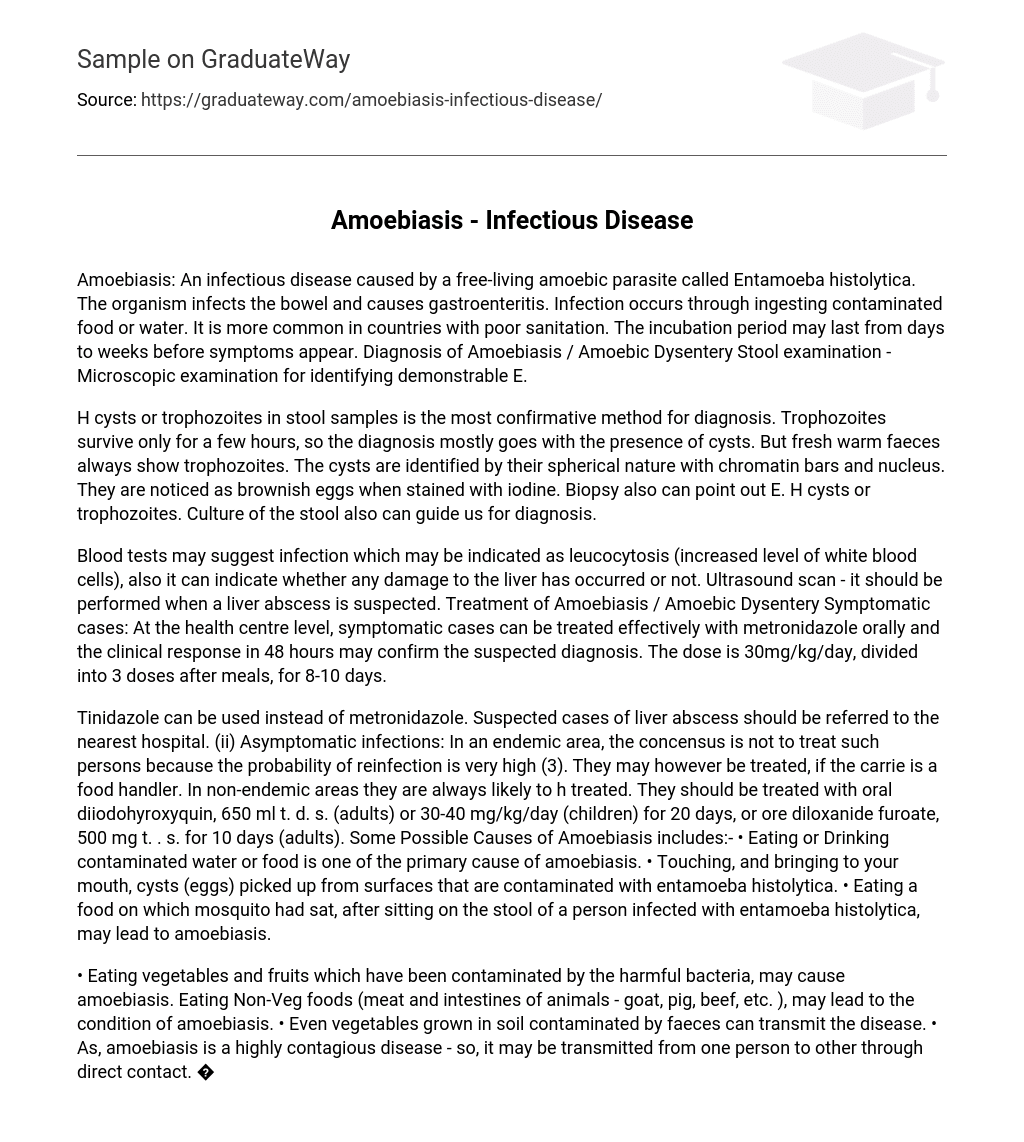Amoebiasis: An infectious disease caused by a free-living amoebic parasite called Entamoeba histolytica. The organism infects the bowel and causes gastroenteritis. Infection occurs through ingesting contaminated food or water. It is more common in countries with poor sanitation. The incubation period may last from days to weeks before symptoms appear. Diagnosis of Amoebiasis / Amoebic Dysentery Stool examination – Microscopic examination for identifying demonstrable E.
H cysts or trophozoites in stool samples is the most confirmative method for diagnosis. Trophozoites survive only for a few hours, so the diagnosis mostly goes with the presence of cysts. But fresh warm faeces always show trophozoites. The cysts are identified by their spherical nature with chromatin bars and nucleus. They are noticed as brownish eggs when stained with iodine. Biopsy also can point out E. H cysts or trophozoites. Culture of the stool also can guide us for diagnosis.
Blood tests may suggest infection which may be indicated as leucocytosis (increased level of white blood cells), also it can indicate whether any damage to the liver has occurred or not. Ultrasound scan – it should be performed when a liver abscess is suspected. Treatment of Amoebiasis / Amoebic Dysentery Symptomatic cases: At the health centre level, symptomatic cases can be treated effectively with metronidazole orally and the clinical response in 48 hours may confirm the suspected diagnosis. The dose is 30mg/kg/day, divided into 3 doses after meals, for 8-10 days.
Tinidazole can be used instead of metronidazole. Suspected cases of liver abscess should be referred to the nearest hospital. (ii) Asymptomatic infections: In an endemic area, the concensus is not to treat such persons because the probability of reinfection is very high (3). They may however be treated, if the carrie is a food handler. In non-endemic areas they are always likely to h treated. They should be treated with oral diiodohyroxyquin, 650 ml t. d. s. (adults) or 30-40 mg/kg/day (children) for 20 days, or ore diloxanide furoate, 500 mg t. . s. for 10 days (adults). Some Possible Causes of Amoebiasis includes:- • Eating or Drinking contaminated water or food is one of the primary cause of amoebiasis. • Touching, and bringing to your mouth, cysts (eggs) picked up from surfaces that are contaminated with entamoeba histolytica. • Eating a food on which mosquito had sat, after sitting on the stool of a person infected with entamoeba histolytica, may lead to amoebiasis.
• Eating vegetables and fruits which have been contaminated by the harmful bacteria, may cause amoebiasis. Eating Non-Veg foods (meat and intestines of animals – goat, pig, beef, etc. ), may lead to the condition of amoebiasis. • Even vegetables grown in soil contaminated by faeces can transmit the disease. • As, amoebiasis is a highly contagious disease – so, it may be transmitted from one person to other through direct contact. • Unhygienic Conditions and Poor Sanitation areas are more susceptible to amoebiasis. • Amoebic dysentery can also be spread by anal sex or directly from person to person contact. Symptoms for Amoebiasis:
The symptoms are in two forms: 1. By burrowing the intestines and making ulcers, which bleed and cause anaemia or other diseases due to added infection 2. Absorbing the food from the host or letting out toxic substances in the intestines Some important symptoms of amoebiasis includes:- • Passing of more number of stools is one of the main symptom in amoebiasis. In this case, patient may pass about 10-12 stools during an acute episode. The presence of mucus is common in stools. • Stools can sometimes also be accompanied with blood Usually symptoms start with diarrhea and pain in right hypochondrium. • Jaundice. • The other most common symptom is colic or pain in abdomen. • It could be associated with a low-grade fever too.
• Sometimes allergic reactions can occur throughout the body, due to release of toxic substances or dead parasites inside the intestines. • Loss of Weight and Stamina is encountered with person suffering from amoebiasis. • Around one in ten people who are infected with amoebiasis become ill from the disease. Tenesmus, may occur during amoebiasis. • Foul smelling stools. • Loss of Appetite. • There will be pain over the liver, when pressure is applied just under the ribs on the right side. • Stomach Cramps. • Amoebic liver abscesses can also present as pyrexia of unknown origin. The abscess can sometimes rupture into the pleural, peritoneal or pericardial cavities. • You will feel weakness or tiredness, if you are suffering from amoebiasis. • Pain in the right shoulder could occur in chronic condition. • Nausea





